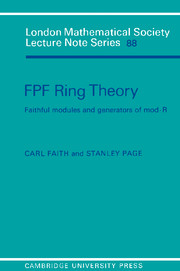Book contents
- Frontmatter
- Contents
- Preface
- Dedication and Acknowledgement
- Introduction
- Chapter 1 The Basics
- Chapter 2 Noncommutative Semiperfect and Semiprime
- Chapter 3 Nonsingular FPF rings
- Chapter 4 Goldie Prime FPF Rings with RRM and the Structure of Noetherian Prime FPF Rings
- Chapter 5 Self-Injective FPF Rings, Thin Rings and FPF Group Rings
- Summary of the Structure of FPF Rings
- Open Questions
- Bibliography
- Abbreviations and Symbols
- Index
Chapter 5 - Self-Injective FPF Rings, Thin Rings and FPF Group Rings
Published online by Cambridge University Press: 05 April 2013
- Frontmatter
- Contents
- Preface
- Dedication and Acknowledgement
- Introduction
- Chapter 1 The Basics
- Chapter 2 Noncommutative Semiperfect and Semiprime
- Chapter 3 Nonsingular FPF rings
- Chapter 4 Goldie Prime FPF Rings with RRM and the Structure of Noetherian Prime FPF Rings
- Chapter 5 Self-Injective FPF Rings, Thin Rings and FPF Group Rings
- Summary of the Structure of FPF Rings
- Open Questions
- Bibliography
- Abbreviations and Symbols
- Index
Summary
In this section we prove the splitting theorem for FPF rings. They split into essentially singular rings and nonsingular rings. The theorem that semi-perfect Noetherian FPF rings are finite products of Dedekind prime rings and Quasi Frobenius rings illustrates the splitting theorem quite well. We will give two proofs of this fact here and give a complete description of Noetherian CFPF rings. The FPF condition is not left right symmetric, i.e. left FPF does not imply right FPF. (It is not even known if non-singular right FPF implies left FPF). It is not known if one sided FPF and Noetherian is enough to achieve a splitting into a product of Dedekind domains and Quasi Frobenius rings. We then examine rings of finite width, i.e. rings for which D(R) is finite (see remarks following Theorem 3.7B). Such rings will be called thin rings. We show, theorem 5.11, that if a ring is self-injective and right FPF, then it is thin and that the converse holds for bounded self-injective rings.
SPLITTING THEOREM (Faith [79b], Page [83b])
If R is right FPF, then there exists a two sided ideal A which is a direct summand of R as a right ideal such that Zr(R) the right singular ideal, is essential in A and R/A is right FPF and nonsingular. Moreover, if R is also left FPF, then R = ⊥A ⊕ A as rings.
- Type
- Chapter
- Information
- FPF Ring TheoryFaithful Modules and Generators of Mod-R, pp. 114 - 139Publisher: Cambridge University PressPrint publication year: 1984

